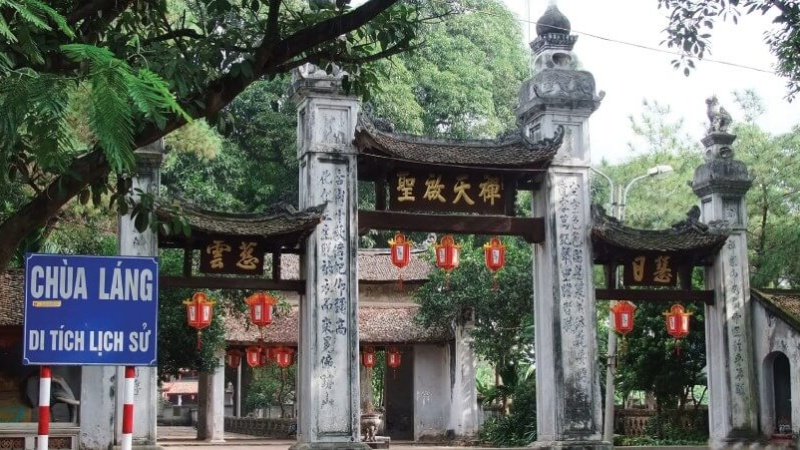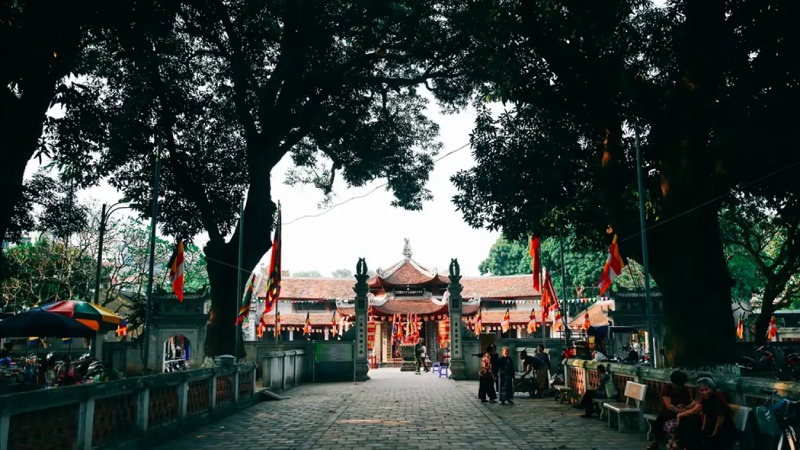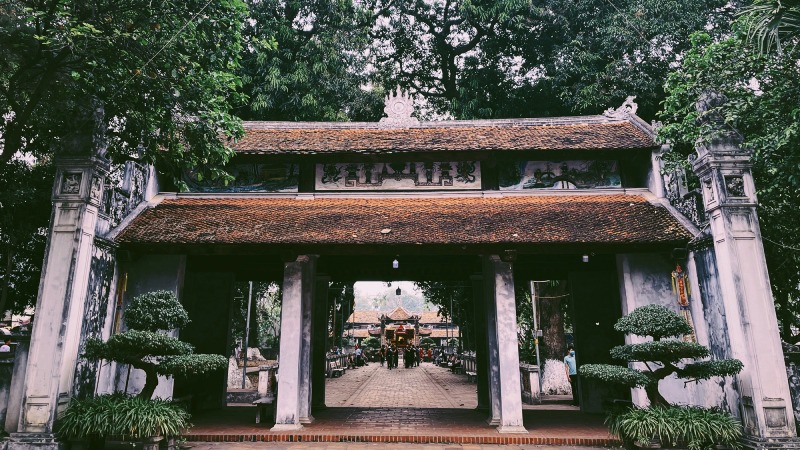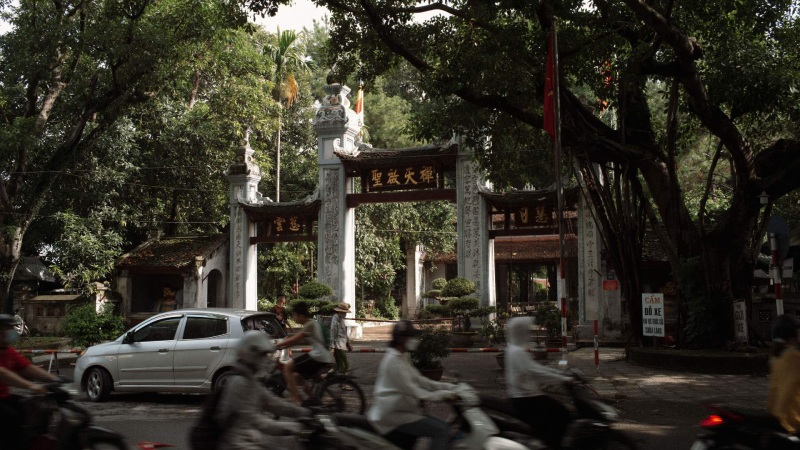Hanoi in March, no longer the cold of winter, not yet the heat of summer, is an ideal time for visitors to explore the cultural and spiritual beauty of the thousand-year-old land. Among the destinations that attract visitors in March, it is impossible not to mention Lang Pagoda, an ancient pagoda located in Dong Da district, Hanoi.
1 Where is Lang Pagoda? How to get to Lang Pagoda?
Lang Pagoda is located at 116 Chua Lang Street, Lang Thuong Ward, Dong Da District, Hanoi. It is about 4km from the city center, you can get to the pagoda by many means such as:
-
Motorbike: This is the most popular and convenient vehicle, you can follow the direction of Tay Son – Lang Ha – Chua Lang.
-
Bus: You can take bus number 02, 09, 13, 33, 45, 50 and get off at Chua Lang bus stop.
-
Taxi: You can call a taxi from reputable companies such as Mai Linh, Vinasun, Grab, Gojek,…
 Where is Lang Pagoda? How to get to Lang Pagoda?
Where is Lang Pagoda? How to get to Lang Pagoda?
2 What does Lang Pagoda enshrine? Some features about the history of Lang Pagoda, Hanoi
Lang Pagoda is located in Dong Da district, Hanoi, and is one of the most ancient and famous pagodas in the capital. It attracts visitors not only because of its unique architecture but also because of its history linked to two legendary historical figures: King Ly Than Tong and Zen Master Tu Dao Hanh.
According to legend, Lang Pagoda was built during the reign of King Ly Anh Tong (1138 – 1175) to commemorate his father King Ly Than Tong and the talented Zen master Tu Dao Hanh. According to legend, Zen Master Tu Dao Hanh was reincarnated as the son of Sung Hien Hau (brother of King Ly Nhan Tong) and later became King Ly Than Tong because King Ly Nhan Tong had no son to succeed him.
Ly Anh Tong, the son of King Ly Than Tong, had this pagoda built to express his heartfelt respect for his father and the Zen master who had made great contributions to the country. Lang Pagoda has undergone many renovations and restorations through the dynasties, including major ones in 1656, 1901 and 1989.
Today, Lang Pagoda is a spiritual destination that attracts a large number of tourists and locals. It not only bears historical and cultural values but is also a serene place for visitors to seek peace of mind.
 What does Lang Pagoda enshrine? Some features about the history of Lang Pagoda, Hanoi
What does Lang Pagoda enshrine? Some features about the history of Lang Pagoda, Hanoi
3 What is special about the architecture of Lang Pagoda?
The temple architecture is imposing and majestic
Based on recorded documents, Lang Pagoda used to have a total of 100 rooms, built in the “inner court, outer country” architectural style. This architectural style has been popular in Vietnam since ancient times, with the highlight being two long corridors connecting the front and back halls, creating a closed rectangular frame. Inside this frame can be a hall of incense burning or an upper temple hall.
Throughout its ups and downs, Lang Pagoda still retains its majestic and splendid appearance with a complex of harmonious and balanced works in the overall surrounding space. The subtle combination of temple architecture, nature, gardens and ancient trees has created a peaceful and tranquil atmosphere. With the most beautiful pine forest in the western part of Thang Long Citadel, Lang Pagoda was once known as “The No. 1 Pine Forest”.
 The temple architecture is imposing and majestic
The temple architecture is imposing and majestic
Tam quan gate has an architecture similar to the gate in the royal palace
Stepping into the pagoda grounds, visitors will be impressed by a majestic Tam Quan gate with a unique architecture, bearing the royal mark. Four square pillars, standing tall and majestic, supporting three curved arched roofs, create a beauty that is both imposing and elegant. This architectural style reminiscent of the Tam Quan gate in the royal palaces of the past, showing the solemnity and sacredness of the pagoda.
Passing through Tam Quan gate, visitors will enter a spacious courtyard paved with Bat Trang bricks. The highlight of the courtyard is a stone slab – where the palanquin of the saint is placed during festival days. Next is the inner Tam Quan with a three-compartment house architecture, two rows of pillars supporting four parallel layers of roofs, arranged in a stacked roof style. Through the inner Tam Quan, the path leading to the main hall is paved with bricks, with ancient mu trees on both sides, creating a serene and ancient space.
A special highlight in the pagoda grounds is the couplets written on blue porcelain shards, which further embellish the solemn and serene beauty here. Each couplet carries a profound meaning, reflecting Buddhist philosophy and teachings for human beings.
 Tam quan gate has an architecture similar to the gate in the royal palace
Tam quan gate has an architecture similar to the gate in the royal palace
Octagonal House has an outstanding architecture
The Octagonal House in Lang Pagoda attracts visitors with its distinctive architecture with a two-story stacked roof, totaling 16 roofs. On top of the roof are 8 writhing dragons, symbolizing the 8 Ly Dynasty kings. Beside the Octagonal House are the main structures of the pagoda including the Worshiping Hall, the Upper Hall, the Incense House, the Ancestor’s House and the Monk’s Quarters.
Lang Pagoda is also famous for its 198 large and small statues, the most impressive of which are the statue of King Ly Than Tong seated majestically on the throne and the statue of Zen Master Tu Dao Hanh. In addition, the pagoda also preserves many valuable treasures such as 31 couplets, 39 horizontal lacquered boards, 15 stone steles… which contribute to increasing the historical and cultural value of the pagoda.
 Octagonal House has an outstanding architecture
Octagonal House has an outstanding architecture
4 Lang Pagoda Festival in Hanoi
Every year, on the 7th day of the 3rd lunar month, the Lang Pagoda Festival is held in Lang Thuong ward with solemn rituals to commemorate Zen Master Tu Dao Hanh, a venerable monk who made great contributions to the history of Vietnamese Buddhism. The festival not only carries spiritual values but also a traditional cultural beauty that attracts a large number of visitors from all over the country.
The highlight of the festival is the procession of the Saint’s palanquin. The procession starts from Lang Pagoda, moves through the streets to Hoa Lang Pagoda to commemorate the Zen Master’s mother. The procession of the palanquin is held solemnly, expressing respect and reverence for the talented






























